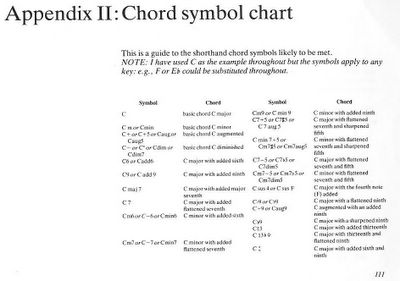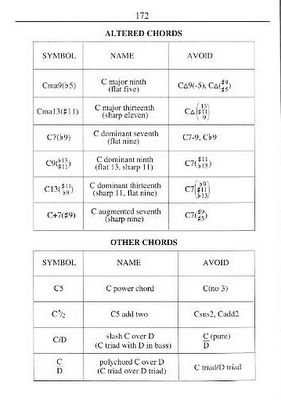Chord Symbols
General Rules for Naming Chords
Taking into account the many ways in which chords may be symbolized, here are some general rules and recommendations worth noting.
• When no symbol follows the chord letter, a major triad is assumed—e.g., the symbol C by itself stands for a C major triad.
• The numbers 7, 9, or 13 alone next to the chord letter means that the chord is a dominant-quality chord—e.g., C9 is "C dominant ninth."
• The symbol "ma," meaning "major," is never used with a chord letter alone, as in "Cma." It is always used together with 7, 9, or 13—as in Cma7, Cma9, or Cma13—and means that the chord includes a major seventh.
• The symbol for a minor triad is the letter name of the chord plus "mi," as in "Cmi." The same symbol is used together with numbers to indicate other minor-quality chords such as Cmi7, Cmi6/9, Cmi11.etc.
• If the seventh is present in a chord, added tones are numbered as extensions. For example, adding a sixth to a C7 chord results in "C13." If the seventh is not present, the added tone is numbered as a simple interval, e.g., "C6."
• Chords with extensions are symbolized by the highest extension present in the chord. For example, C13 indicates a dominant seventh chord quality with an added thirteenth. (The other extensions may or may not actually be voiced in the chord, depending on other factors.)
• The symbol "+" refers to the augmented fifth only, not an augmented ninth or eleventh. For example, the symbol C+9 means "C dominant 9 augmented fifth," not "C augmented ninth."
• All alterations are written in parentheses, such as Cmi7(b 5). When more than one alteration is present, they are shown one above the other, with the largest alteration on top, such as C7( b9 b5).
• #11 chords may contain a natural fifth degree, but b5 chords do not.
• Eleventh chords may contain a third, but sus chords do not.
The following, from Hal Leonard Pocket Music Theory, A Comprehensive and Convenient Source for All Musicians, is a reference list of chord symbols based on the principles listed above. Also included are some common names that you should learn to recognize but that should generally be avoided due to their ambiguity. While it may never be possible to achieve total consistency in the world of chord symbols, a common-sense regard for clarity will go a long way.






